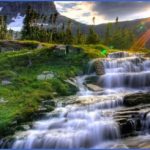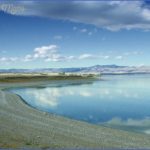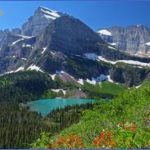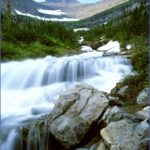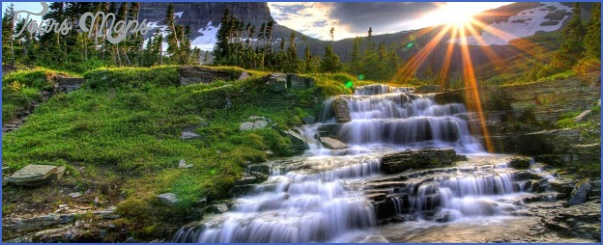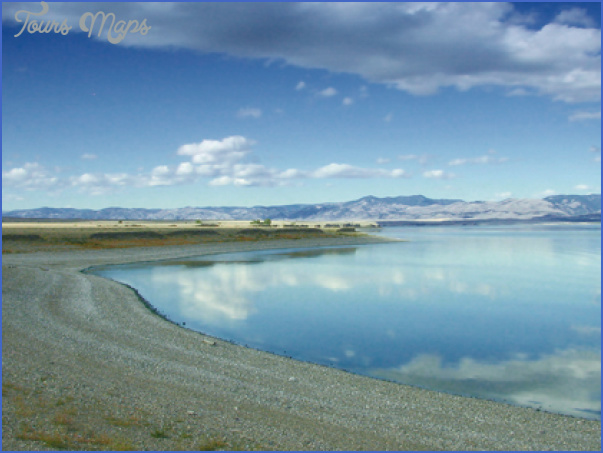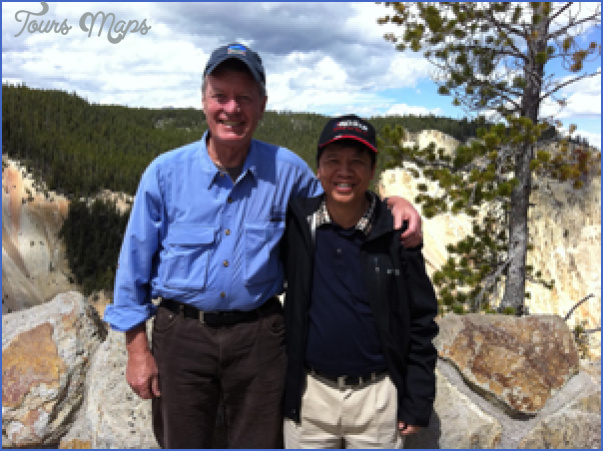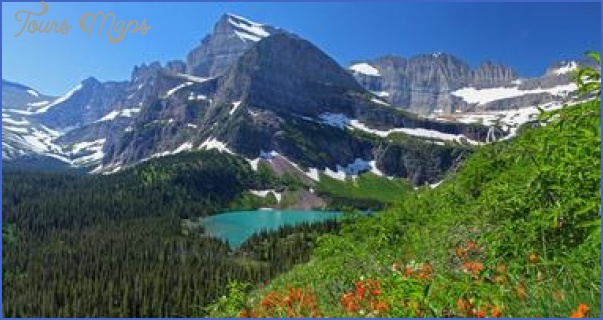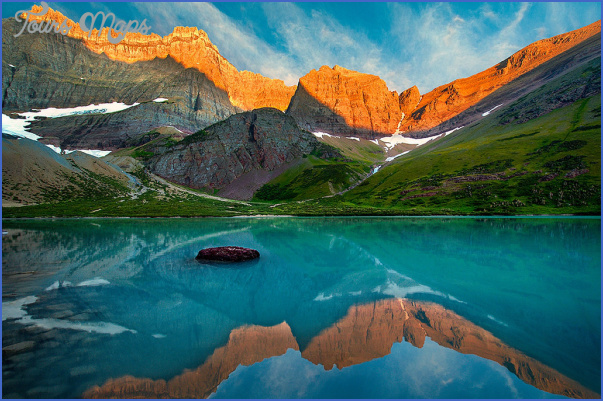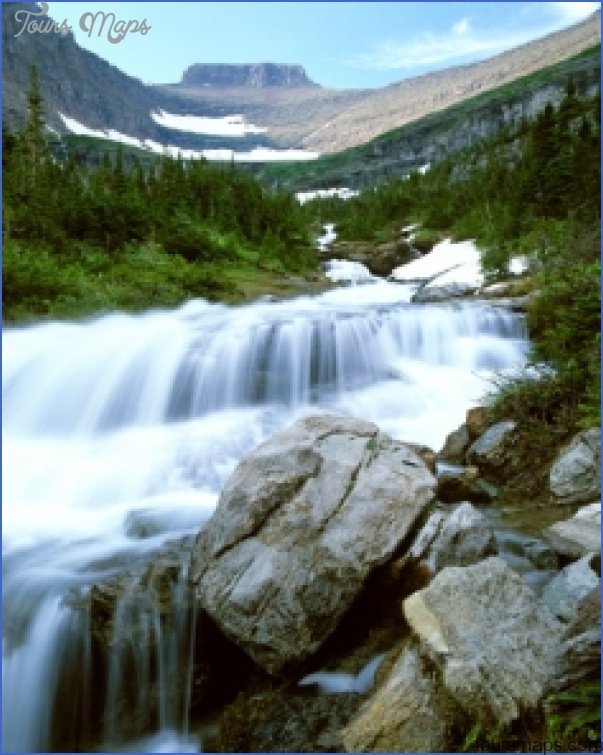THE MISSOURI RIVER NEAR CRAIG IS A FLY FISHERMAN’S PARADISE
ON THE EDGE OF WILDERNESS
The Rocky Mountain Front WOLF CREEK TO BROWNING
Estimated length: 136 miles estimated time: 6 hours to 2 days
Highlights: Milford Colony, Sun River Game Preserve, Old Trail Museum, Pine Butte Swamp Preserve, Teton Pass Ski Area, Miller Colony, Two Medicine Dinosaur Center, Egg Mountain, Museum of the Plains Indian, Scapegoat and Bob Marshall wilderness areas
Getting there: From I-90, go north on I-15 out of Butte through Helena to the US 287 and exit 2 miles north of Wolf Creek. This is what Lewis and Clark referred to as The Gates of the Mountains. Upon leaving the freeway, you’ll cross a strip of the Rocky Mountain Front into the prairie and the beginning of a drive that bobs all the way to Browning on the Blackfeet Indian Reservation.
OVERVIEW
The Rocky Mountain Front technically stretches from the Canadian border near Glacier National Park to northern New Mexico, but for the most part, only here can you see the great American prairie as it once was sweeping, undulating, often-unscarred native rangelands rising gently to meet the sheer walls of the Northern Rockies and rugged Bob Marshall Wilderness, known simply to locals as the Bob. This is the country of A. B. Guthrie, the famed author of westerns who lived outside Choteau. The region is so striking that it stirred a rare coalition of locals ranchers, Blackfeet, business owners, recreationists, politicians, and even some energy companies to protect the Front from oil and gas drilling as well as subdivision, so that it would retain its rugged character and all that comes with it for current and future generations. In late 2014, nearly forty years after the seeds of protection were first conceived, the Rocky Mountain Front Heritage Act was signed into law, ensuring that a roughly 100-mile strip from East Glacier south to Rogers Pass would be safe from exploitation. About 67,000 acres were added to the wilderness system, but the act also created a 208,000-acre special conservation zone set aside for traditional uses such as motorized recreation, timber thinning, and grazing, and has elements that help family ranchers remain on the land.
The movement began in 1977 when Pendroy taxidermist Dusty Crary and Choteau elementary schoolteacher Gene Sentz started Friends of the Front, with the support of ranchers and sportsmen who feared that encroaching energy development would end their way of life as it already had in parts of New Mexico and Colorado. Their concerns were heard by Lewis and Clark National Forest supervisor Gloria Flora, who had the rare courage to ban drilling on the Front at a time when her brethren were rubber-stamping leases across the West. Because of those efforts, and because of the care that multigenerational cattle-ranching families have had for an unforgiving landscape where Chinook winds come howling off the mountainsides at up to 100 mph, people are living, working, and playing in harmony with nature here. And you get to immerse yourself in a rare world.
The Front has some of the nation’s best intact wildlife habitat and is home to the second-longest elk migration in the United States. Grizzlies wander the foothills. In recent years, some have occasionally sauntered more than 100 miles across the plains to the Missouri River between Great Falls and Fort Benton, the first time in a century that the great bear has been seen on the edge of the Missouri Breaks.
The Rocky Mountain Front byway starts in ponderosa pines near the Gates of the Mountains at Wolf Creek and ends in rolling sage country just east of Glacier National Park in Browning, site of the Blackfeet tribal headquarters. Along the way you’ll pass through the charming ranching and outdoor recreation communities of Augusta, Choteau, and Dupuyer. While Choteau was Guthrie’s home, Dupuyer is the setting for many works by the acclaimed Western author Ivan Doig, who died in 2015. It’ll take some discipline to resist the urge to gaze out the driver’s side of the car toward the jagged Wailing and Castle Reefs, especially at sunrise and sunset.
Lodging and dining are available, but consider gearing up in Helena before you start. Take a tour of the state capital its decor captures the essence of Montana’s heritage as well as any building in the state.
HITTING THE ROAD
As you come north from Helena on I-15, you’re on what was once a toll road through a pine canyon between Fort Benton and Helena. Today, Wolf Creek (pop. 510) is a jumping-off point for fishing the trout-rich Missouri River and Holter Lake.
Canyon Ferry Lake
The route begins 2 miles past Wolf Creek at US 287 (Exit 228). The highway immediately begins a gradual rise out of the pines through the Front, denoted by rolling grass prairie, pine ridges, coulees, and periodic streams, starting with the Dearborn. Amid grazing cattle, look for mule deer and pronghorn antelope the second-fastest land mammal in the world in the 27 miles between I-15 and the junction of MT 200 at Bowman’s Corners.
Coming into view in the west now are such limestone peaks as Blowout, Table, Steamboat, and Lone Chief, which rise from the Scapegoat Wilderness Area. Just past Bowman’s Corners is the 12,000-acre Milford Colony, one of 50 Hutterite communities across Montana and the state’s oldest. The Hutterites (or Hoots, as they are commonly called locally) are a self-sufficient, independent, and peaceful people of Eastern European descent who live simple agricultural lives similar to the Amish and Mennonites. Colonists frequently venture out to sell baked goods, produce, turkeys, chickens, and crafts in rural communities. Don’t worry about feeling intrusive, despite an eerie lack of discernible activity. Follow the signs for fresh vegetables and fryers, and eventually a welcoming party, usually led by young boys in colorful suspenders, will greet you.
Visit to Montana Photo Gallery
Maybe You Like Them Too
- The Best Cities To Visit in The World
- World’s 10 Best Places To Visit
- Coolest Countries in the World to Visit
- Travel to Santorini, Greece
- Map of Barbados – Holiday in Barbados


